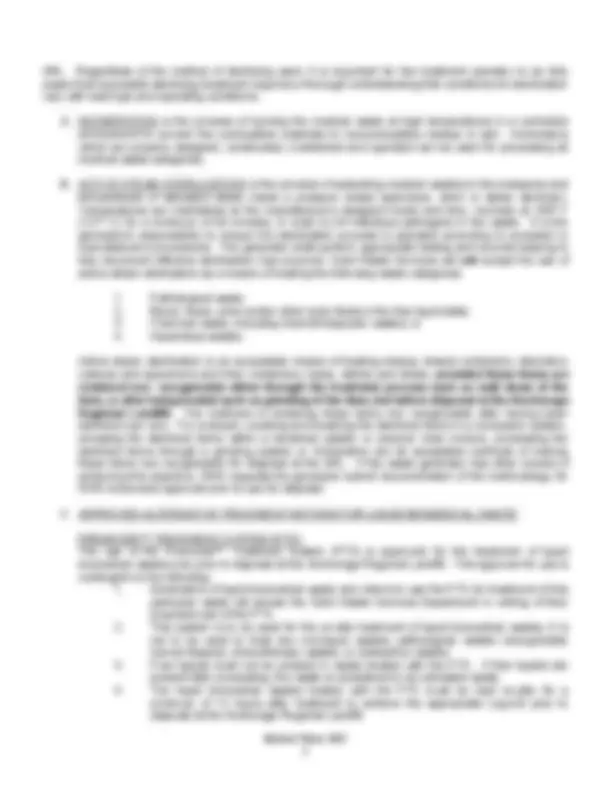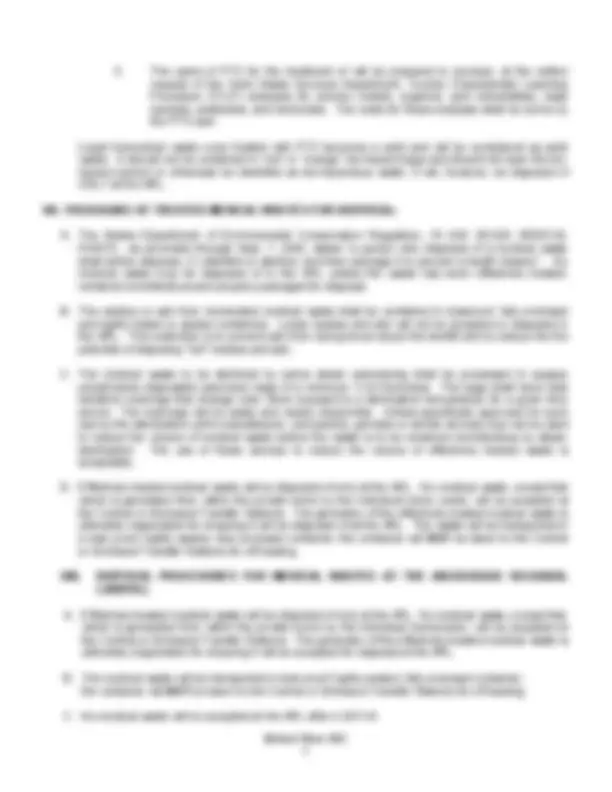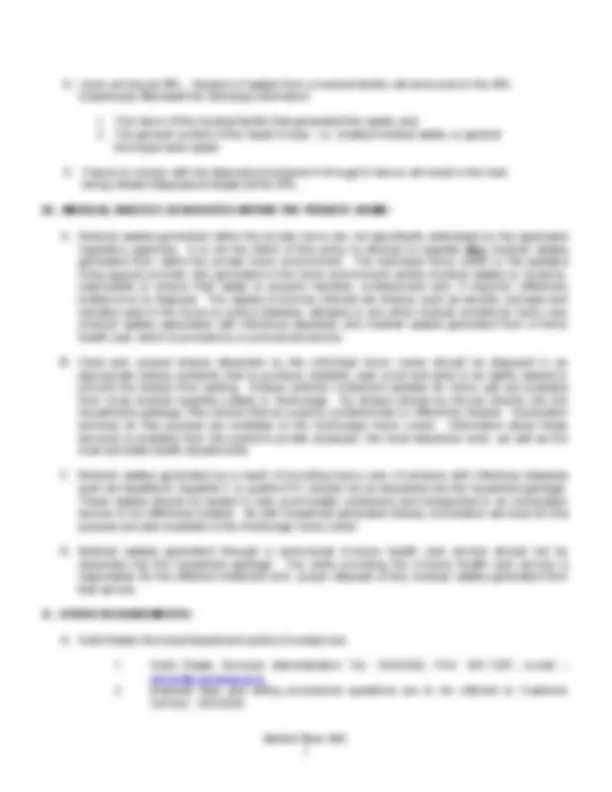





Study with the several resources on Docsity

Earn points by helping other students or get them with a premium plan


Prepare for your exams
Study with the several resources on Docsity

Earn points to download
Earn points by helping other students or get them with a premium plan
Community
Ask the community for help and clear up your study doubts
Discover the best universities in your country according to Docsity users
Free resources
Download our free guides on studying techniques, anxiety management strategies, and thesis advice from Docsity tutors
The regulations and policies for disposing medical waste in Anchorage, Alaska. It covers the types of medical waste, acceptable treatment methods, and specific disposal procedures for various waste categories. The document also provides contact information for the Solid Waste Services Department and the Anchorage Regional Landfill.
Typology: Lecture notes
1 / 6

This page cannot be seen from the preview
Don't miss anything!




EFFECTIVE DATE: January 31, 1991 REVISED DATE: April 1, 2008
I. AUTHORITY TO ESTABLISH DISPOSAL POLICY:
The authority by which the Municipality of Anchorage, Solid Waste Services (SWS) Department establishes disposal policies and procedures and conducts disposal operations is contained within the Anchorage Municipal Code and the State of Alaska Department of Environmental Conservation's Solid Waste Management Regulations, 18 AAC 60, as amended through Sept. 7, 2002.
II. PURPOSE:
The purpose of the MEDICAL WASTE DISPOSAL POLICY is to protect SWS' workers, the public and the environment from exposure to pathogens which could cause diseases. Indiscriminate disposal of infectious wastes in garbage may potentially expose refuse workers to diseases. Since package integrity cannot be ensured during collection and land filling, loss of containment may result in releasing infectious wastes into the environment, endangering the SWS' workers, the public and the environment itself.
III. APPLICABILITY:
This policy applies to any private or public medical, dental or veterinary clinic, office, facility, laboratory, hospital or service within the Municipality of Anchorage which generates, collects or processes medical waste with the intent of disposing the waste at the Anchorage Regional Landfill (ARL). Specific medical wastes generated from within the private home environment by the individual homeowner or by a commercial in-home health care service is addressed separately in Section VII of this policy. Ordinarily, waste material that is generated ONLY within the Municipality of Anchorage is accepted for disposal at the ARL. Medical waste material that has been generated outside of the Municipality of Anchorage, and processed within the Municipality, may on a case by case basis, and as determined by the Medical Waste Project Administrator (907-343-6262, Fax 907-561-1357, e-mail wwsws@ci.anhcorage.ak.us), be accepted at the ARL. It is requested that a processor who desires to process medical waste generated outside the Municipality of Anchorage with the intent to dispose of the processed waste in the ARL, contact SWS at the above number before proceeding.
IV. GENERAL POLICY:
Medical wastes shall not be disposed of at the ARL until they have been EFFECTIVELY TREATED , that is, rendered biologically harmless in accordance with acceptable treatment practices as described in this policy or current industry standards and methods and the wastes do not pose other hazards subject to Municipal, State or Federal laws or regulations. Effectively treated medical wastes will be disposed of only at the ARL, located at the Glenn Highway and Hiland Road. No medical waste, except that which is generated by the individual homeowner within the private home environment, will be accepted at the SWS’ Central Transfer Station, located at 1111 East 56th Avenue in Anchorage, or the Girdwood Transfer Station, located on Ruane Road in Girdwood.
Medical Waste 2002
For the purpose of this policy, SWS embraces the definition of MEDICAL WASTE as defined in ADEC Solid Waste Management, 18 AAC 60, as amended through Sept. 7, 2002, page 111, definition number (78): " ‘medical waste’ means laboratory waste consisting of discarded cultures and stocks of infectious agents and associated microbiologicals; pathological wastes; selected isolation wastes; used and unused discarded sharps; animal waste; human blood, or blood products; and other wastes defined as ‘regulated waste’ in 29 C.F.R. 1910.1030(b), revised as of Sept. 7, 2002.”
A. ANIMAL WASTES: Discarded material originating from an animal inoculated with an infectious agent during research, production of biologicals, or pharmaceutical testing; includes the carcass, body parts, blood, and bedding of any animal known to have been in contact with an infectious agent [ADEC Solid Waste Management, 18 AAC 60, as amended through Sept. 7, 2002, page 105, definition number (10)].
B. BLOOD AND BLOOD PRODUCTS: Discarded waste human blood and blood components, including serum and plasma, and materials containing free-flowing blood and blood components [ADEC Solid Waste Management, 18 AAC 60, as amended through Sept. 7, 2002, page 106, definition number (23)].
C. CULTURES AND STOCKS: Discarded cultures and stocks of infectious agents and associated microbiologicals, including human and animal cell cultures from medical and pathological laboratories, cultures and stocks of infectious agents from research and industrial laboratories, waste from the production of biologicals, discarded live and attenuated vaccines, and culture dishes and devices used to transfer, inoculate, or mix cultures of infectious agents [ADEC Solid Waste Management, 18 AAC 60, as amended through Sept. 7, 2002, page 107, definition number (35)].
D. PATHOLOGICAL WASTES: Discarded pathological waste, including human tissues, organs, and body parts removed during surgery, autopsy, or other medical procedures [ADEC Solid Waste Management, 18 AAC 60, as amended through Sept. 7, 2002, page 112, definition number (93)].
E. SELECTED ISOLATION WASTE: Discarded waste material that is contaminated with excretions, exudates, and secretions from patients with highly communicable diseases, and that is treated in isolation, includes blood and blood components, and sharps [ADEC Solid Waste Management, 18 AAC 60, as amended through Sept. 7, 2002, page 115, definition number (123)].
F. SHARPS: Discarded implements or parts of equipment used in animal or human patient care, medical research, or industrial laboratories, including hypodermic needles; syringes, Pasteur pipettes, scalpel blades, blood vials, needles with attached tubing, broken or unbroken glassware that has been in contact with an infectious agent, slides, cover slips, and unused, discarded implements or parts of equipment [ADEC Solid Waste Management, 18 AAC 60, as amended through Sept. 7, 2002, page 116, definition number (127)].
An acceptable treatment method is any technique or process designed to change the biological character or composition of medical waste so that it is no longer infectious or otherwise biologically hazardous. The most commonly accepted treatment methods are incineration and active steam sterilization. Use of other treatment methods, including chemical disinfection, microwave radiation sterilization and thermal inactivation, are either quite specific or unique in their applications and as such will require case-by-case prior review and written approval by the SWS before such treated waste will be accepted for disposal at the
Medical Waste 2002
Liquid biomedical waste once treated with PTS becomes a solid and will be considered as solid waste. It should not be contained in “red” or “orange” bio-hazard bags and should not bear the bio- hazard symbol or otherwise be identified as bio-hazardous waste. It will, however, be disposed of ONLY at the ARL.
VII. PACKAGING OF TREATED MEDICAL WASTES FOR DISPOSAL:
A. The Alaska Department of Environmental Conservation Regulation, 18 AAC 60.030. MEDICAL WASTE., as amended through Sept. 7, 2002, states "a person who disposes of a medical waste shall before disposal, (1) disinfect or sterilize, and then package it to prevent a health hazard;". No medical waste may be disposed of in the ARL unless the waste has been effectively treated, rendered noninfectious and properly packaged for disposal.
B. The residue or ash from incinerated medical waste shall be contained in leakproof, fully enclosed and tightly lidded or sealed containers. Loose residue and ash will not be accepted or disposed in the ARL. This restriction is to prevent ash from being blown about the landfill and to reduce the fire potential of disposing "hot" residue and ash.
C. The medical waste to be sterilized by active steam autoclaving shall be processed in opaque polyethylene disposable autoclave bags of a minimum 3 mil thickness. The bags shall have heat sensitive markings that change color when exposed to a sterilization temperature for a given time period. The markings will be easily and clearly discernible. Unless specifically approved for such use by the sterilization unit's manufacturer, compactors, grinders or similar devices may not be used to reduce the volume of medical waste before the waste is to be rendered noninfectious by steam sterilization. The use of these devices to reduce the volume of effectively treated waste is acceptable.
D. Effectively treated medical waste will be disposed of only at the ARL. No medical waste, except that which is generated from within the private home by the individual home owner, will be accepted at the Central or Girdwood Transfer Stations. The generator of the effectively treated medical waste is ultimately responsible for ensuring it will be disposed of at the ARL. The waste will be transported in a leak proof, tightly sealed, fully enclosed container; the container will NOT be taken to the Central or Girdwood Transfer Stations for off loading.
VIII. DISPOSAL PROCEDURES FOR MEDICAL WASTES AT THE ANCHORAGE REGIONAL LANDFILL
A. Effectively treated medical waste will be disposed of only at the ARL. No medical waste, except that which is generated from within the private home by the individual homeowner, will be accepted at the Central or Girdwood Transfer Stations. The generator of the effectively treated medical waste is ultimately responsible for ensuring it will be accepted for disposal at the ARL.
B. The medical waste will be transported in leak proof, tightly sealed, fully enclosed container; the container will NOT be taken to the Central or Girdwood Transfer Stations for off loading.
C. No medical waste will be accepted at the ARL after 4:30 P.M.
Medical Waste 2002
D. Upon arriving at ARL, Haulers of wastes from a medical facility will announce to the ARL Scalehouse Attendant the following information:
E. Failure to comply with the disposal procedures A through D above will result in the load being refused disposal privileges at the ARL.
IX. MEDICAL WASTES GENERATED WITHIN THE PRIVATE HOME:
A. Medical wastes generated within the private home are not specifically addressed by the applicable regulatory agencies. It is not the intent of this policy to attempt to regulate ALL medical wastes generated from within the private home environment. The individual home owner or the assisted living support provider who generates in the home environment certain medical wastes is, however, responsible to ensure that waste is properly handled, containerized and, if required, effectively treated prior to disposal. The wastes of primary interest are sharps, such as lancets, syringes and needles used in the home to control diabetes, allergies or any other medical conditions; home care medical wastes associated with infectious diseases; and medical wastes generated from in-home health care which is provided by a commercial service.
B. Used and unused sharps discarded by the individual home owner should be disposed in an appropriate sharps container that is puncture resistant, leak proof and able to be tightly sealed to prevent the sharps from spilling. Sharps collector containers suitable for home use are available from most medical supplies outlets in Anchorage. No sharps should be thrown directly into the household's garbage, they should first be properly containerized or effectively treated. Incineration services for this purpose are available to the Anchorage home owner. Information about these services is available from the person's private physician, the local telephone book, as well as the local and state health departments.
C. Medical wastes generated as a result of providing home care of persons with infectious diseases such as hepatitis B, hepatitis C or positive HIV should not be discarded into the household garbage. These wastes should be sealed in leak proof plastic containers and transported to an incineration service to be effectively treated. As with household generated sharps, incineration services for this purpose are also available to the Anchorage home owner.
D. Medical wastes generated through a commercial in-home health care service should not be discarded into the household garbage. The entity providing the in-home health care service is responsible for the effective treatment and proper disposal of any medical wastes generated from that service.
X. OTHER REQUIREMENTS:
A. Solid Waste Services Department points of contact are: